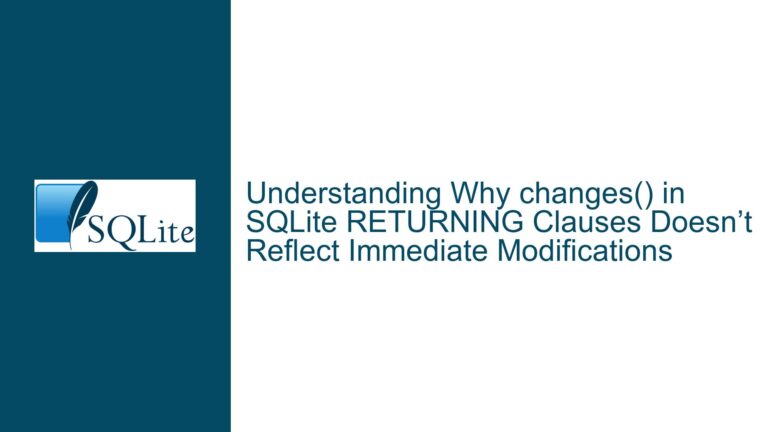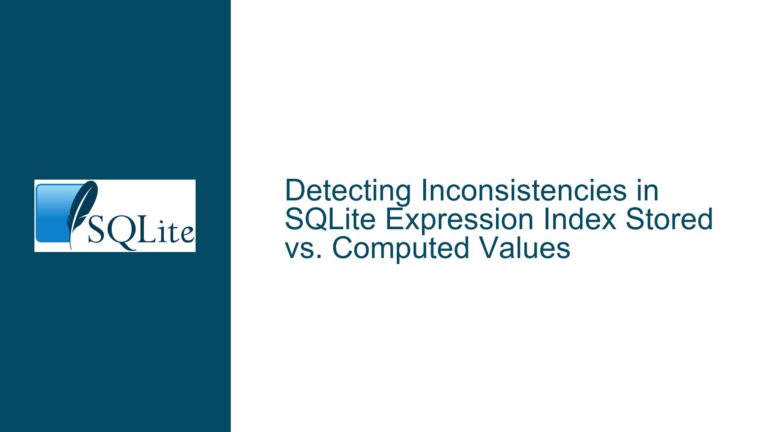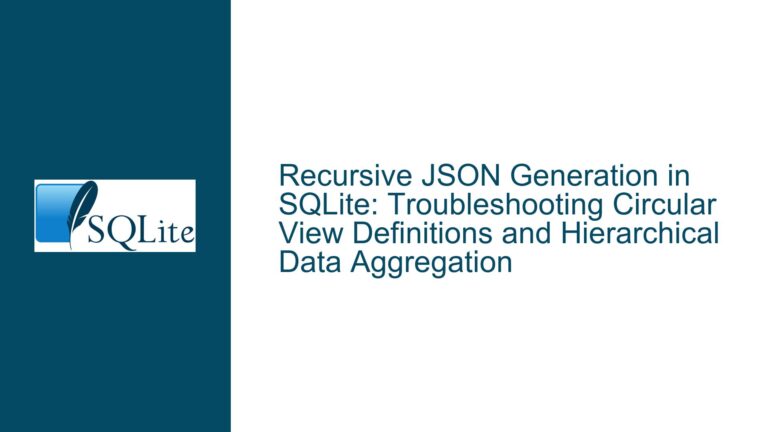Unintended NULL Updates Due to Correlated Subquery Omissions in SQLite
Issue Overview: Correlated Subquery Context Leads to Silent NULL Updates
When executing an UPDATE statement in SQLite, developers may encounter scenarios where a subquery within the SET clause unintentionally returns NULL, leading to silent updates of column values to NULL instead of raising an error. This behavior occurs due to the interplay between SQLite’s permissive syntax rules, correlated subquery resolution, and the absence of explicit table references in subqueries.
In the provided example, the user attempted to update the textdata column of the uptest table using a subquery that inadvertently omitted a FROM clause. The intended logic was to retrieve textdata from another row (indexRow=1) and assign it to the row where indexRow=2. However, the subquery (select textdata uptest where indexRow=1) was parsed without error, resulting in the textdata column being set to NULL for indexRow=2.
The confusion arises because SQLite allows subqueries to reference columns from the outer query (correlated subqueries) even when no FROM clause is present. This leads to scenarios where the subquery’s WHERE clause references the outer table’s columns, causing the subquery to evaluate to NULL if no matching rows exist in the outer context. The absence of explicit table aliases or FROM clauses in the subquery exacerbates this issue, as SQLite defaults to resolving column names against the outer table.
Possible Causes: Permissive Syntax and Column Resolution Ambiguity
1. Absence of FROM Clause in Subqueries
SQLite does not require a FROM clause in a SELECT statement. A subquery like SELECT 1 or SELECT column_name (without FROM) is syntactically valid. When a FROM clause is omitted, the subquery operates in a "correlated" context, resolving column names against the outer query’s tables. In the example, the subquery select textdata uptest where indexRow=1 lacks a FROM clause, causing textdata and indexRow to resolve against the uptest table from the outer UPDATE statement. The WHERE indexRow=1 condition references the outer table’s indexRow column, which is 2 in the current row being updated. This mismatch causes the subquery to return NULL.
2. Column Name Resolution Hierarchy
SQLite resolves column names using a hierarchical process:
- Local Scope: Columns in the subquery’s
FROMclause (if present). - Outer Query Scope: Columns from tables referenced in the outer query (correlated subqueries).
When a FROM clause is missing, all column references default to the outer scope. This creates ambiguity when the developer intends to reference a different table but omits the FROM clause. For example, if the subquery was meant to select from a different table (e.g., other_table), the absence of FROM other_table causes SQLite to misinterpret textdata and indexRow as belonging to the outer uptest table.
3. Silent NULL Assignment in UPDATE Statements
SQLite does not enforce strict type checking or existence constraints by default. If a subquery returns no rows or evaluates to NULL, the SET clause assigns NULL to the target column without raising an error. This behavior is consistent with SQL standards but can lead to unintended data modifications if the subquery logic is flawed.
Troubleshooting Steps, Solutions & Fixes: Enforcing Explicit References and Error Handling
1. Use Explicit Table Aliases and FROM Clauses
To avoid ambiguous column resolution, always include a FROM clause in subqueries and use table aliases to disambiguate column references. For example:
UPDATE uptest
SET textdata = (
SELECT u.textdata
FROM uptest AS u -- Explicit FROM and alias
WHERE u.indexRow = 1
)
WHERE indexRow = 2;
Here, the subquery explicitly references the uptest table with alias u, ensuring that indexRow=1 refers to the subquery’s table, not the outer query’s row. If the FROM clause is omitted, SQLite will parse the query as a correlated subquery, leading to unintended results.
2. Enable Error Reporting for Ambiguous Queries
SQLite does not provide a built-in mechanism to flag missing FROM clauses. However, developers can use the following strategies to catch errors:
- Linter Tools: Use SQL linters (e.g.,
sqlfluff,sqlcheck) to enforce strict syntax rules during development. - Testing Frameworks: Implement unit tests that validate query results against expected outcomes.
- Explicit Constraints: Add
NOT NULLconstraints to columns ifNULLis not an acceptable value:CREATE TABLE uptest ( indexRow INTEGER PRIMARY KEY, textdata TEXT NOT NULL -- Disallow NULL values );If the subquery returns
NULL, theUPDATEwill fail with aNOT NULL constraint failederror.
3. Use Correlated Subqueries Intentionally
If correlated subqueries are intended, ensure the logic aligns with the outer query’s context. For example, to copy textdata from the row where indexRow=1:
UPDATE uptest
SET textdata = (
SELECT textdata
FROM uptest AS u
WHERE u.indexRow = 1
)
WHERE indexRow = 2;
This explicitly references the uptest table in the subquery, decoupling it from the outer query’s row context.
4. Debugging Techniques
- Use
RETURNINGClause: TheRETURNINGclause in SQLite 3.35+ allows inspection of updated rows:UPDATE uptest SET textdata = (SELECT textdata WHERE indexRow = 1) WHERE indexRow = 2 RETURNING *;This returns the modified row, revealing unexpected
NULLvalues. - Isolate Subqueries: Test subqueries independently by replacing variables with literals:
SELECT textdata FROM uptest WHERE indexRow = 1; -- Expected: 'ABC'
5. Schema Design Considerations
- Foreign Keys: Use foreign keys to enforce referential integrity if subqueries reference other tables.
- Triggers: Create triggers to validate data before updates:
CREATE TRIGGER validate_textdata_update BEFORE UPDATE ON uptest FOR EACH ROW BEGIN SELECT RAISE(ABORT, 'textdata cannot be NULL') WHERE NEW.textdata IS NULL; END;This trigger aborts the
UPDATEiftextdatais set toNULL.
By understanding SQLite’s column resolution rules and adopting explicit query design practices, developers can prevent silent NULL updates and enforce data integrity.






